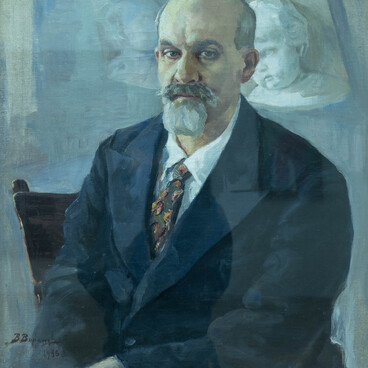The fate of a native of Udmurtia, Pyotr Vasilyevich Pavlov, is closely associated with Chuvashia. There, after graduating from the Surikov Institute, he worked in the studios of the art foundation and taught at the the Art and Graphics department of the Chuvash State Pedagogical University and the Cheboksary Art College. It was there that he painted his most famous works dedicated to the country’s past and present, distinguished by their perfect composition and elaborate structure of imagery and colors. Among them are “Earth”, “Red Plowmen”, “Communard’s Funeral” and other monumental narrative canvases.
The artist’s keen interest in portrait painting was largely due to the cultural tradition that was firmly established in Chuvashia in the 1970s. The portrait occupied a prominent place in art, with virtually all leading artists — from the elders of the Chuvash painting to the artist’s peers — invariably paying special attention to portraiture. The social range of characters portrayed by Pavlov is very wide. These are creative intellectuals, contemporary urban intelligentsia. Their images reveal the complex work of human thought, deep inner concentration, spiritual richness of individual, nuanced emotional undertones, subtle variations in the state of mind, a complex unity of conflicting feelings, and ambiguity of figurative characteristics.
One of these works is the “Portrait of the Composer Viktor Khodyashev.” It is discreet and concise, its composition only featuring the details indispensable for visual characterization. This is a portrait, where the objects around the central character are carefully and deliberately selected: a black grand piano with a white row of keys waiting for the touch of the musician’s hands, music sheets held by the composer behind his back. The surroundings help to reveal the image of the person being portrayed, without drawing the focus of attention; they are not supposed to substitute what is really important in any portrait — the human face. There is a kind of understatement and uncertainty in the nature of the composer. Behind the outward restraint, one can see both austerity and a quiet, measured disposition.
The artist’s keen interest in portrait painting was largely due to the cultural tradition that was firmly established in Chuvashia in the 1970s. The portrait occupied a prominent place in art, with virtually all leading artists — from the elders of the Chuvash painting to the artist’s peers — invariably paying special attention to portraiture. The social range of characters portrayed by Pavlov is very wide. These are creative intellectuals, contemporary urban intelligentsia. Their images reveal the complex work of human thought, deep inner concentration, spiritual richness of individual, nuanced emotional undertones, subtle variations in the state of mind, a complex unity of conflicting feelings, and ambiguity of figurative characteristics.
One of these works is the “Portrait of the Composer Viktor Khodyashev.” It is discreet and concise, its composition only featuring the details indispensable for visual characterization. This is a portrait, where the objects around the central character are carefully and deliberately selected: a black grand piano with a white row of keys waiting for the touch of the musician’s hands, music sheets held by the composer behind his back. The surroundings help to reveal the image of the person being portrayed, without drawing the focus of attention; they are not supposed to substitute what is really important in any portrait — the human face. There is a kind of understatement and uncertainty in the nature of the composer. Behind the outward restraint, one can see both austerity and a quiet, measured disposition.



